#Ringfort
Explore tagged Tumblr posts
Text









This was a home once - Part I
#ireland#rath#ringfort#archaeology#ruins#abandoned#medieval#nature photography#original photographers#photographers on tumblr#my photography#green#witch aesthetics#forest photography#celtic#gaelic#pagan aesthetic
31 notes
·
View notes
Text
Ring fort and Abbey..










#nature#outdoors#photography#photos#pretty#hobby#sky#snapchat#filters#warm#dark#ringfort#abbey#Winter#December#Saturday#grass#moss#heather#circle#ground#walk#trip#angel#window#light#steps#part 1#Afternoon
16 notes
·
View notes
Text










Cahergall Cashell (Ringfort), County Kerry, Ireland
#cahergall#cahergall cashell#ringfort#my photography#Ireland#l'll tell you what; climbing up all those steps this time with a bum knee was hair-raising
35 notes
·
View notes
Text



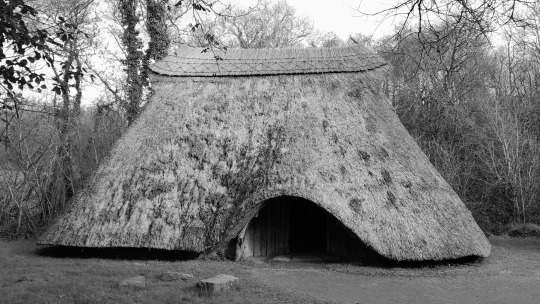
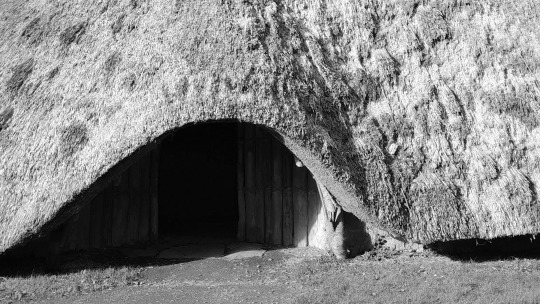
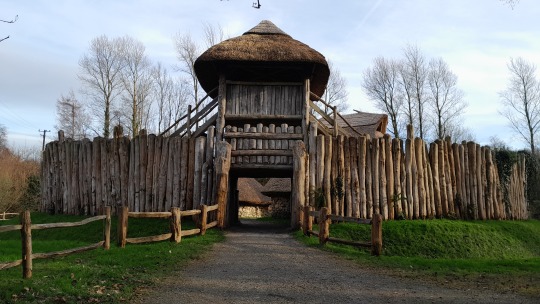
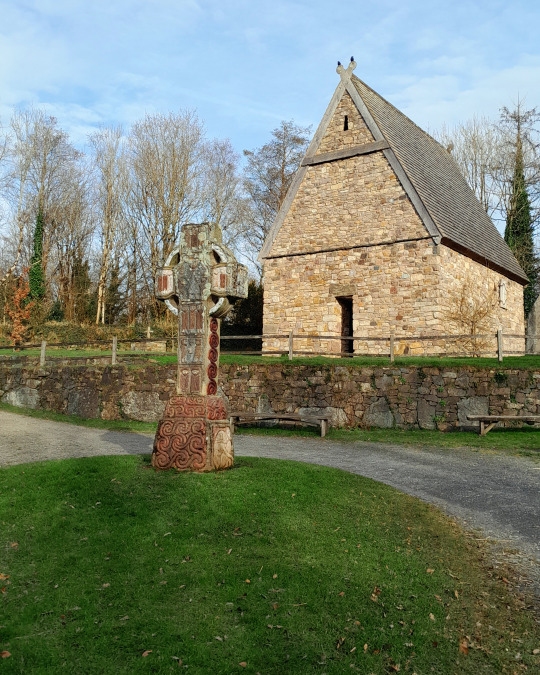
The Irish National Heritage Park is one of the coolest places I've visited in Ireland. Not only does it preserve some actual nature, but there's also reconstructions of various (pre)historic houses and such - even a crannog! The photos above show:
-crannog, on a small artificial island on a lake
-mesolithic huts of hunter-gatherers
-neolithic hut of agriculturalists
-medieval ringfort
-Christianized middle ages
#archaeology#experimental archaeology#irish national heritage park#mesolithic#neolithic#prehistory#history#medieval#travel#photo#ireland#irish history#ringfort#crannog
107 notes
·
View notes
Text
Ion age Celts Casually building cool forts in the most scenic landscapes

2 notes
·
View notes
Text
Visiting a dolmen
Day is muggy, has us both sulky Pasty Irishers not made for sun Kissing your poisoned lips at the megalith Enormous light-eclipsing capstone Sits strangely angled, how was it lifted into place in ancient day I imagine cow-tramped trails, movable log ramps along which longstones travelled Burnt offerings and the bones of chieftains interned within Selfsame beneath my skin, I make an…
#alchemisland#alchemy#am writing#antiquities#art#author#craft#creative writing#dolmen#drugs#dublin#expression#imagination#ireland#irish#magick#megalith#neuralchemy#OC#poem#poet#poet’s corner#poetblr#poetry#poetry community#poetryblr#rhyme#rhyming#ringfort#spilled ink
1 note
·
View note
Photo

Distribution of known Ringforts across Ireland.
211 notes
·
View notes
Text
THE WORLD OF ICE & FIRE
Reading Order & Thoughts Apparently
//Investigative read with the aim of finishing a fanfic <SPOILERSGALORE>

~this is not intended to be useful in any way shape or form do not construe as such but laughing at it is ok~
The Dawn Age
-dragonglass arrowheads found in giant ribs could be from children-giant war but also cud just as easily be wight giant
-brandon the builder was taken to a secret place by the children when he sought help to build the wall hmmmmmm okk
-“the manner in which Brandon learned to comprehend the speech is a tale in itself and not worth repeating here”?????? WTAF fuck u condal i mean yondel tommen loves stories
-greenseers can see distant events AND COMMUNICATE?hmmmmmmmmmmmmmmmmplotdevice
-wolfcontrolling skinchangers maxxx common, separately called wargs? stark blood fuckfest much????
-Seastone chair on old wyk wo any ppl SUSSAUCE
The Coming of the First Men
-alleged timing 8000-12000 yrs ago hmmmmm if ww are 6000 yrs ago it’s almost halfway hmmmmmmm
-what they running from? first men possible valyrian ancestors upset w the animalxhuman experiments? conveniently vague time periods
-first settled on DORNE that goddamned desert summins up w ur magic stone i will find u
-greenmen antlermen same same????
-arm of dorne, marshes, all considered natural disasters but w doubt so why not children cause doom of valyria possible??
The Age of Heroes
-ringforts this ringforts that fist of first men this infrastructure that
-find thenn constr. & every single built structure NotW
The Long Night
-do monkeys and elephants have anything in common
-Barth’s “fragmentary treatise” everything shat out by Barth & Munkun makes me want to kms
-Fomas ur understated & prolly right u religious fuck
The Rise of Valyria
-new power in east right after LN recovery, what festive timing gee i wonder if these events r related
-first empire ofc ofc just after old ghis & Qarth & YiTi & Asshai but those r “claims” yea we don’t talk bout that look dragons! blood sacrifice!
-five great wars w ghis “when the world was young” hmmmmmmmm
-Shadow texts say dragons tamed by “people who had no names” hmmmmmmmm
Valyria’s Children
-Qohor&Norvos founded following religious schisms? Only Qohor smiths still know to rework VS
-way way way too many mentions of wealth & human flesh needed in the mines
-fire vs water
-sus that andals & rhoynar both fled from Valyrians but in the second coming “the gods” spoke to the HS while the waterbenders fought both times
-is the long night just fire vs water 2.0?
Arrival of the Andals
-wtf is a fucking swan maiden
-writing the lines of the hugor hill story backwards is not as great a puzzle as u seem to think
-Urron Redhand ruled IIs by “axe&sword” for 1000 yrs, throwaway name? I think the fuck not.
Ten Thousand Ships
-Nymeria of Ny Sar SUS naming
-“few wish to dwell beyond the sound of her eternal song” faith close to old gods
-wtf r the orphans of the greenblood upto
-davos dayne my new OC, forgive me as i project onto u for the forseeable future
-seriously tho the best part so far, need a movie for THIS not whatever fart pudding they baking
The Doom of Valyria
—wtf is the difference between the 14 fires & R’hollor summins weird
-accidental poisoning of one of the flames? like pollution but magical bywaste pollution
-red clouds rained down dragonglass???? and black blood of demons which cud just be dragon blood as they pop in the air from toxicity
-dothraki & sellsword companies both popularised only in the power vacuum
-the conquerer’s attention lay west even as a child hmmmmmm
#reading order is going to be a bit different than published#qarth#asshai#yiti#and all them eastern cities#essos#westeros#fire and blood#the hedge knight#and then the original series#a song of ice and fire#im not sure if this commentary is meta or meta enough but it is what it is#asoiaf#a game of thrones#asoiaf fandom#asoiaf meta#book commentary#asoiaf fanfiction#first time reading#book talk#reading the books#game of thrones#ao3#bookblr#reading#reading order#the world of ice and fire#twoiaf#reading twoiaf#a world of ice and fire
19 notes
·
View notes
Text
Faerie Types + Related Creatures:
Sprites: derived from the Latin word "spiritus", a sprite is a type of fae, often described as a tiny humanoid with insect-like wings, unlike nymphs who look like beautiful humans. Size and appearance can vary depending on what they are the sprite of.
Kelpies: water horse spirits found in scottish myth capable of shape shifting. They inhabit the Lochs and pools of Scotland. It is described to look like a horse, but can take a human form. Said to delight in drowning its victims. In certain stories, it loves the human liver.
Pixies: Little folk found in English folklore, especially around Devon and Cornwall. pixies are believed to inhabit ancient underground sites such as stone circles, barrows, dolmens, ringforts, or menhirs. In traditional regional lore, pixies are generally benign, mischievous, short of stature, and childlike; they are fond of dancing and wrestling outdoors, of which they perform through the night.
Changelings: creatures spoken of in many folklore, fantasy, and fairy tales from across European mythology. They are regarded as creatures that are placed into mortal homes by fairies or demons, who proceed to kidnap the original child of the home
Cù Sìth: found in scottish myth, the cú sìth is a hound and harbinger of death. Said to reach sizes as big as a young bull. Its fur is described as shaggy and dark green (sometimes white) in colour. Its tail is either coiled up or braided and its paws are the same width as a man's hand. Shares similarities to the Cwn Annwn
Elves: humanoid beings that originate from Germanic mythology and folklore. In medieval Germanic-speaking cultures, elves generally seem to have been thought of as beings with magical powers and supernatural beauty, ambivalent towards everyday people and capable of either helping or hindering them
Knocker: a helpful spirit of a previous fatality in the tin mines. A knocker is about 2 feet high, has a disproportionately large head, long beard and weathered, wrinkled skin. Their long arms almost touch the ground and they imitate the miner's clothes in dress, and carry such things as pickaxes and lamps. Some believed the knocking on the cave walls caused by knockers were attempts to break down the walls, others that the knocks were directions on where to dig and others still that the knocks were warnings of an impending collapse.
Tuatha dé Dannan: are a supernatural race in Irish mythology. They are thought to represent the main deities of pre-Christian Gaelic Ireland. Prominent members of the Tuath Dé include The Dagda, who seems to have been a chief god; The Morrígan; Lugh; Nuada; Aengus; Brigid; Manannán, a god of the sea; Dian Cecht, a god of healing; and Goibniu, a god of metalsmithing and one of the Trí Dé Dána
Wulver: a humanoid wolf creature that is part of the folklore of the Shetland islands off the coast of Scotland. The wulver kept to itself and was not aggressive if left in peace, and he will often guide lost travellers to nearby towns and villages. There are also tales of Wulvers leaving fish on the windowsills of poor families.
Dwarfs: found primarily in Germanic mythology, dwarves were magical creatures with great skill in metallurgy, making them famous and often the craftsmen for powerful artifacts of legend. They have strong associations with death and the earth (dark hair, pale skin) in mythology, and often dwelled within mountains and mines. Late Norse concepts of dwarves were quite different from the German and Dutch Folklore, where they were unseen magical creatures like fairies and gnomes; users of charms, curses, and deceit.
Boggart: is generally a household spirit turned malevolent trickster or mishcevious goblin-like creature. The name is derived from the Welsh "bwg". When a hobgoblin is teased or misused excessively, it will become a Boggart — creatures whose sole existence is to play tricks and cause trouble for people. They can be mischievous, frightening, and even dangerous, and they are very difficult to get rid of. Boggarts also tend to punish those who offend them and in some cases are trying to punish a human for injustice.
Hobgoblin: a spirit of the hearth, typically appearing in folklore, once considered helpful but since the spread of Christianity has often been considered mischievous.
47 notes
·
View notes
Text



This was a home once - Part II
#my photography#photographers on tumblr#original photographers#nature photography#ireland#rath#ringfort#ruins#archaeology#nature#ancient#celtic#pagan aesthetic#forest aesthetic#sunset#golden hour#abandoned#medieval
19 notes
·
View notes
Text
More views from the Ringfort!💚








#Ringfort#post#tumblr#new post#Winter#December#Saturday#Afternoon#day#outdoors#nature#photography#photos#pretty#hobby#sky#flowers#snapchat#filters#warm#weather#ring#circle#stone#interest#walk#Adventure#trip#Grass#colours
18 notes
·
View notes
Text
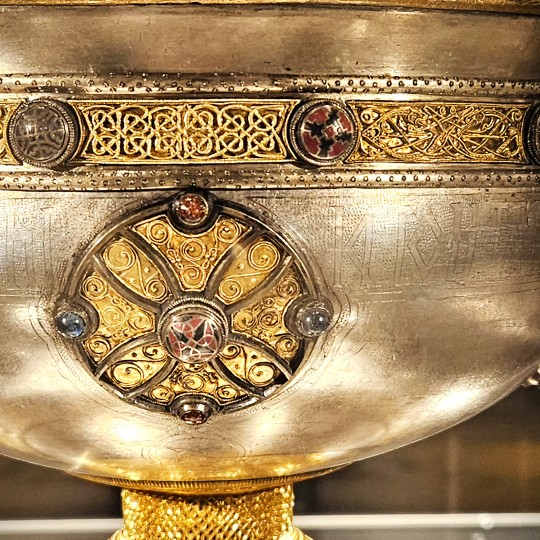
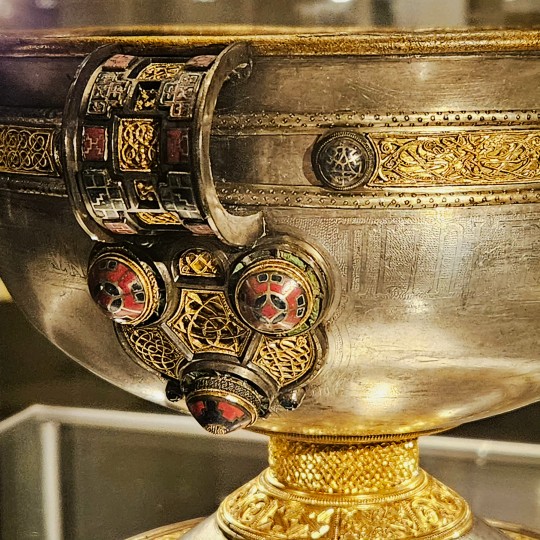

Ardagh Chalice
The Ardagh Chalice is one of the greatest treasures of the early Irish Church. It is part of a hoard of objects found in the 19th century by a young man digging for potatoes near Ardagh, Co. Limerick. It was used for dispensing Eucharistic wine during the celebration of Mass. The form of the chalice recalls late Roman tableware, but the method of construction is Irish.
The bowl and foot of the chalice are made of spun silver. The outer side of the bowl is decorated with applied gold, silver, glass, amber and enamel ornament. The underside of the foot is also highly decorated and contains a polished rock crystal at the centre.
The bowl is attached to the stem and foot by a bronze pin. The names of eleven apostles and St. Paul are inscribed below the band of gold filigree and studs encircling the bowl. The letters are seen against a stippled background. Incised animal decoration can also be seen below two handle escutcheons, which are decorated with elaborate glass studs and filigree panels.
The Ardagh Chalice represents a high point in early medieval craftsmanship and can be compared in this regard to the Tara Brooch and the Derrynaflan Paten.
text: National Museum of Ireland
c8th century, silver, gilt copper, gold filigree, gold, gilt bronze, silver, polychrome glass, amber, rock crystal, 18 cm high, 19.5 cm in diameter at the rim, found in a hoard in the ringfort of Reerasta, near Ardagh, County Limerick, Ireland
https://smarthistory.org/the-ardagh-chalice/
78 notes
·
View notes
Text

An ancient ringfort, inside of which someone has built a house, because of reasons. Not like there wasn't a ton of free space around the precious ancient monument. Lissanduff Earthworks, Northern Ireland.
#photo#travel#lissanduff earthworks#northern ireland#ringfort#ancient#acrhitecture#earthworks#megalithic#ancient ireland#ireland
2 notes
·
View notes
Text

2mm Celtic village: mould, unpainted, painted
Took a beginner sculpting/mould-making class yesterday. It was FX/film-oriented, but we're talking similar principles to poured miniatures anyway.
A proper ringfort would've been larger, with a proper gate and all that, but this gets the point across on the tabletop. With 2mm Ancients seeming to be the most common period I've personally seen at that scale, starting with appropriate scenery makes sense. All my 2mm stuff currently is Renaissance, but that's likely to change in the near future.
Overall, I'm happy with this as a first mould and I'm excited to continue sculpting and mould-making until I have pieces I'd feel proud of seeing on others' tabletops.
12 notes
·
View notes
Text

A gaeilge cover of The Summer King by the Forgetmenauts
My lyrics, an English translation, and tags under the cut
Gaeilge (English)
Chan an abhainn go binn i mí na Luil (The river sings gently in July)
Shuigh sé ann lena craiceann gorm (He sits there with his blue skin)
Bhí greim agam ar luachair (I gripped at the rushes)
Nuair a ghlaoigh Rí Samhraidh orm. (When the Summer King called to me)
Rug sé ar caol na lámhe orm (He took me by the wrist)
Bhí sé séimh ach láidir freisn (he was gentle but also strong)
“Luigh liom ar leaba na habhann ("Lie with me on the river bed)
Fan go fóil beag,”ar saesin. (For a while," he said."
Ní fheicfidh mé na duillí dearg (I will not see the red leaves)
‘Gus ní bheidh mo gheimhrí fuar. (And my winters will not be cold)
Cronóidh mé blathanna an earraigh (I will miss the spring flowers)
Ach tá gach rud ceart go leor. (But everything will be alright.)
Chuiramar sceach gheal ar fud na tíre (We planted hawthorn all over the country)
Fásfaidh agus bláthfaigh muid le chéile (We will grow and bloom together)
Choróin na noníní agus ráth arsa (Daisy crown and ancient ringfort)
Fanaimid leis an lá féile. (We will wait for the festival day)
Tags: @charlataninred @rusalkaandtheshepherdgirl @bella-daonna @unseeliethot @grimalkinsquill (ask to be added or removed)
#SnaG 2023#the forgetmenauts#egg kohna#is mise an crann#please never ask me to do this again it was so hard thinking of rhymes#<<< nobody asked and i will probably do this again when i forget how annoying that was#scheduled post
92 notes
·
View notes


